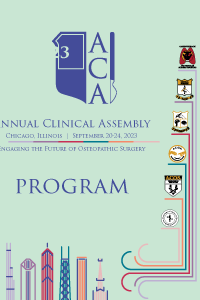Urological Surgery
Iatrogenic Ureter Injury and Repair: Comparing Repair Techniques in Ureter End-to-End Anastomosis
Location: Grandball Room 1-2
- ni
nwamaka iloani
University of North Texas Health Science Center - TCOM
Sugar Land, Texas, United States
Primary Presenter(s)
Introduction/Purpose: The ureter is a delicate structure due to its size and anatomical location. It is found deep within the retroperitoneal space and the lower third of the ureter lies adjacent to numerous pelvic structures such as the uterine artery, cervix, vagina, colon, and iliac vessels, and due to its proximity, the ureter is subject to unintentional accidental injury during diagnostic or medical procedures, termed iatrogenic. This paper and associated aim to explore the odds of iatrogenic ureteral injuries (IUI) when comparing different surgical methods, discuss the best preventative options and review the current repair measures, as well as any associated complications. The aim of this study focused on ureter transection that require surgical repair using a ureterouretal anastomosis, a procedure that ligates the free ends of the transected ureter together.
Methods or Case Description: Ureters were obtained from anesthetized Yorkshire pigs via standard laparotomy [protocol: IACUC-20-0011]. Ureters were transected laterally midway along the length of the harvested ureter. In Group A ureters, 2 standard stay sutures were placed 180˚ degrees opposite one another to anchor the ureter and ligated using a simple continuous running suture technique. In Group B, ureters were anchored in a similar fashion with stay sutures and ligated using glue to perform the anastomosis. 500 mL saline was then flushed through the ureter to assess the structural integrity of the ureterouretal anastomosis
Outcomes: Group A ureters showed less stricture formation and fluid leakage at the site of anastomoses, indicating that the standard suture technique used in ureter repair is a safe and reasonable gold standard. In contrast, Group B ureters showed stricture formation and some fluid leakage at suture/glue line, indicating the method of ureter anastomoses was inferior. When IV saline was pushed in Group B ureters, the fluid often exited the ureter at both the suture site and the end portion of the ureter, more so than the Group A ureters.
Conclusion: Future study needs to be conducted in suture/glue method as it is promising. Thoeries such as permanent uretral stent placements to decrease stricture formation in the suture/glue repair method may be a reasonable idea. However, it is not at the level where it can replace current ureter repair end to end anastomoses gold standard.
Methods or Case Description: Ureters were obtained from anesthetized Yorkshire pigs via standard laparotomy [protocol: IACUC-20-0011]. Ureters were transected laterally midway along the length of the harvested ureter. In Group A ureters, 2 standard stay sutures were placed 180˚ degrees opposite one another to anchor the ureter and ligated using a simple continuous running suture technique. In Group B, ureters were anchored in a similar fashion with stay sutures and ligated using glue to perform the anastomosis. 500 mL saline was then flushed through the ureter to assess the structural integrity of the ureterouretal anastomosis
Outcomes: Group A ureters showed less stricture formation and fluid leakage at the site of anastomoses, indicating that the standard suture technique used in ureter repair is a safe and reasonable gold standard. In contrast, Group B ureters showed stricture formation and some fluid leakage at suture/glue line, indicating the method of ureter anastomoses was inferior. When IV saline was pushed in Group B ureters, the fluid often exited the ureter at both the suture site and the end portion of the ureter, more so than the Group A ureters.
Conclusion: Future study needs to be conducted in suture/glue method as it is promising. Thoeries such as permanent uretral stent placements to decrease stricture formation in the suture/glue repair method may be a reasonable idea. However, it is not at the level where it can replace current ureter repair end to end anastomoses gold standard.

